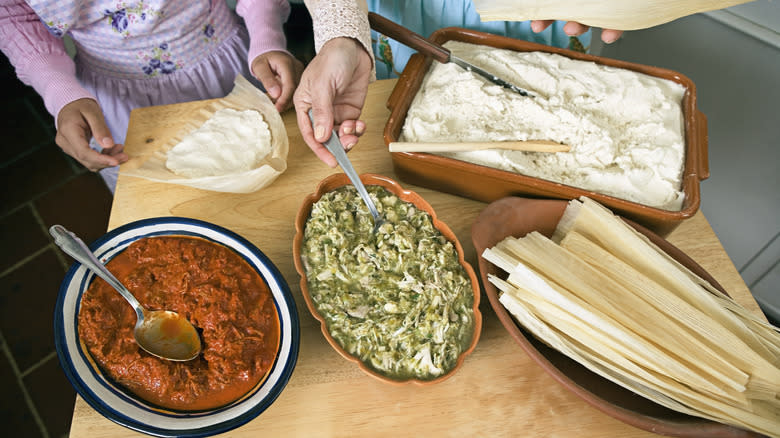Why Tamales Are So Difficult To Perfect At Home

Tamales are a Mexican dish of meat, beans, or cheese wrapped in a dough made from corn known as masa, and the number of flavors and sauces they can be paired with — ranging from savory to sweet — is downright amazing. There's a reason, however, why home cooks often choose to buy tamales rather than make them themselves. Preparing tamales is a time-consuming endeavor, which not only requires a commitment of a few hours but also knowing what pitfalls to avoid so you don't end up with a tray of subpar ones. And as it turns out, there's quite a lot that can go wrong; tamales can turn out too dry, too oily, undercooked, or overcooked.
The first element to tackle in making a tamale is forming the dough. A ground corn flour called masa harina is mixed with fat and liquid. Pork lard is often cited as the perfect fat for this dish, and the liquid can be water or stock. Salt and other spices are usually added to season the masa. (And here's one of the places where home cooks run into trouble.) You have to make sure that your dough is hydrated enough so it doesn't turn out dry and mixed thoroughly so that the masa has a lighter texture. You can test the consistency of the dough by placing a piece of it in a glass of water. If the dough floats, it's well mixed.
Read more: Try These 8 Traditional Mexican Dishes
Filling Troubles And Cooking Mishaps

Even once you've mastered the masa, you're still not out of the woods when it comes to tamales. That's because filling them properly takes not just practice but a sense of restraint. The key is to not go by feel at first and use tools to stick to fixed quantities. It can be helpful to use an ice cream scoop for the masa to keep the amount used consistent. You're only looking to use about ? of a cup in each corn husk. And go even more sparingly with the filling — consider two tablespoons the limit. Too much filling will make it hard to adequately wrap the tamales, and it may leak out as well.
Cooking the tamales improperly can also lead to lackluster results. Tamales are usually steamed, and timing is everything. If you cook them for too long, the masa inside will be tough, and the filling will be dry. Keep the steamer over medium heat to give you more control over the cooking process, and make sure not to overcrowd the tray so that there's plenty of circulation. The exact cooking time for the tamales may vary from recipe to recipe, but the telltale sign that the tamale is ready is when the corn husk separates from the masa without effort.
Read the original article on Tasting Table.
